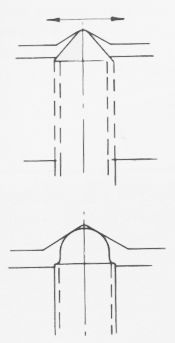Posted by HOWARDT on 20/01/2019 18:31:52:
Regarding the grubsrew end form. Both will work equally as well, since there is more than one screw in contact. Any error in position between the gib dimples and the tapped holes means contact will made on one side with posibly the first tightened having full position contact.
Um. Nope not really. Sort of true if gib screws are exactly aligned with the receiving dimples in the gib with both being cleanly shaped and undamaged. In practice, especially on more affordable a machines sufficiently perfect alignment is unlikely.
Taper gibs took over, initially on industrial machines, not because they are inherently better but because they are cheaper to make once more than "OK when new I suppose" or "Fine if carefully set-up" quality is needed. Highest quality conventional parallel gib systems like the double doweled assemblies on my Smart & Brown 1024 are clearly very expensive to make because each assembly has to be made and fitted individually. Taper set-ups can be machined to suit a standard gib using ordinary series production methods. Theoretically Smart and Brown style gibs can run with closer clearances than taper ones. About half as a taper gib needs space for an oil film both sides if it is to be adjusted. Whether its really worth the effort I know not. I supposed the sliding gib block style used for a while on some Colchesters is theoretically the best but making it well enough to prove the point is probably a nightmare as more surfaces need to be machined accurately.
At the lower end the simple pointed screw in dimple system works quite well enough given sympathetic adjustment. Inevitably the points and dimples slowly wear as the gib shuffles back and forth fractionally when the direction of slide movement changes. Very slowly if proper adjustment is maintained. Faster if left to run slack. Eventually screw points and dimples wear sufficiently asymmetrically to make adjustment difficult and perfect setting impossible. Whatever your views on the engineering niceties most folk would agree a couple of decades or so of good performing life is a pretty reasonable trade off for a machine you can actually afford.
What really doesn't help is when Harry the Hamfisted gets short tempered with the adjustment and winds the screws up way too tight. Bent, partially flattened points on the screws with relatively deep matching gouges in the dimples are seriously not a recipe for easy, effective and accurate adjustment!
Time for the GHT treatment. I've applied it to machines so badly abused that the original gib screws would only lock at full turn intervals where damaged tips and gouged dimples aligned. Thats where slight positioning mismatches between screw and dimple really turn round and bite.
Danny
Dowelling the gibs will improve performance even after your ball bearing drive modification. More in longer time between adjustment and longer life than anything noticeable right now I suspect. Although the ball bearing modification is theoretically inferior to the full GHT treatment it's far more tolerant of slight mismatch between dimple and screw position.
GHT requires that the screw and gib countersink holes are positionally matched to very close limits to get the full benefits. I've always considered it essential to make a new, close fitting, gib and clamp everything up into the working position with the gib hard up into the top of the dovetail so the countersunk recesses can be produced in exactly the right place by drilling through the screw holes. Best way is to drill out the old screw threads and fit timesert thread inserts after producing the recesses. But thats going a bit far even for me.
Clive.
Clive Foster.






